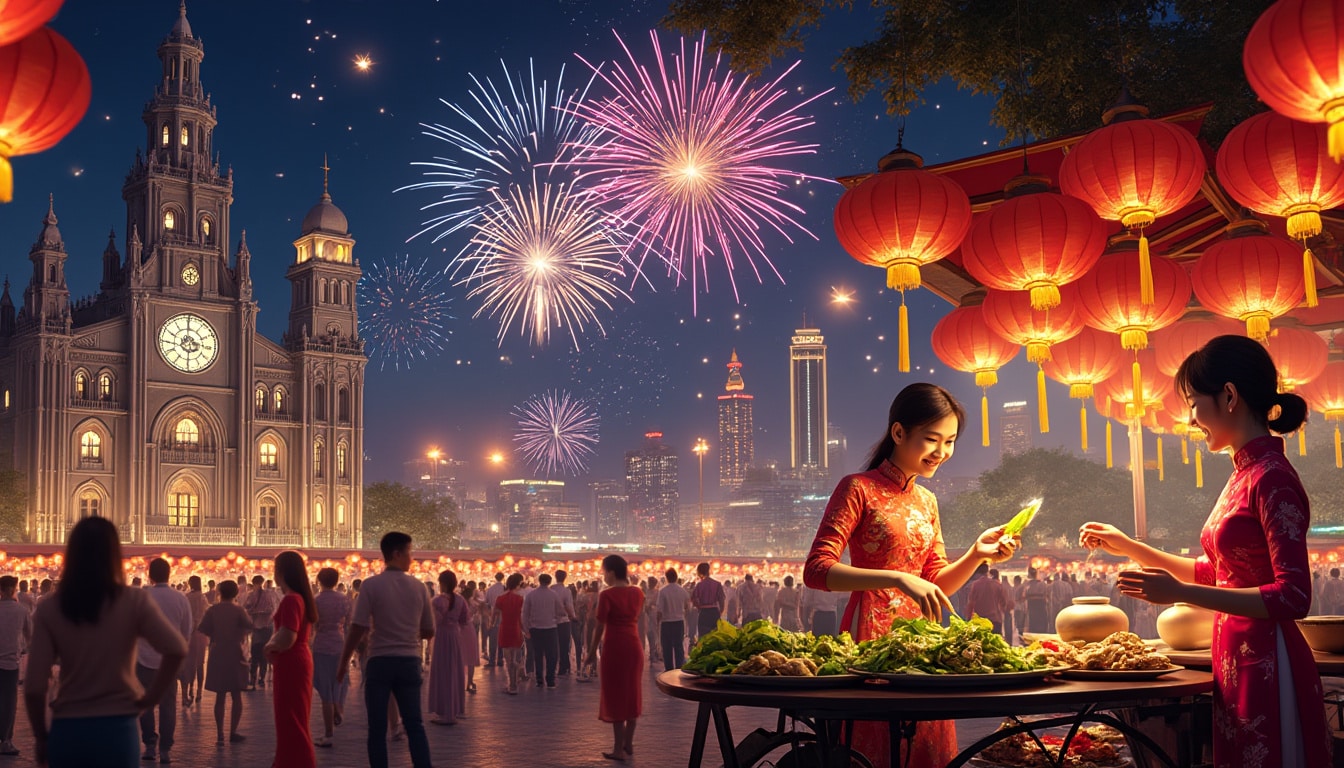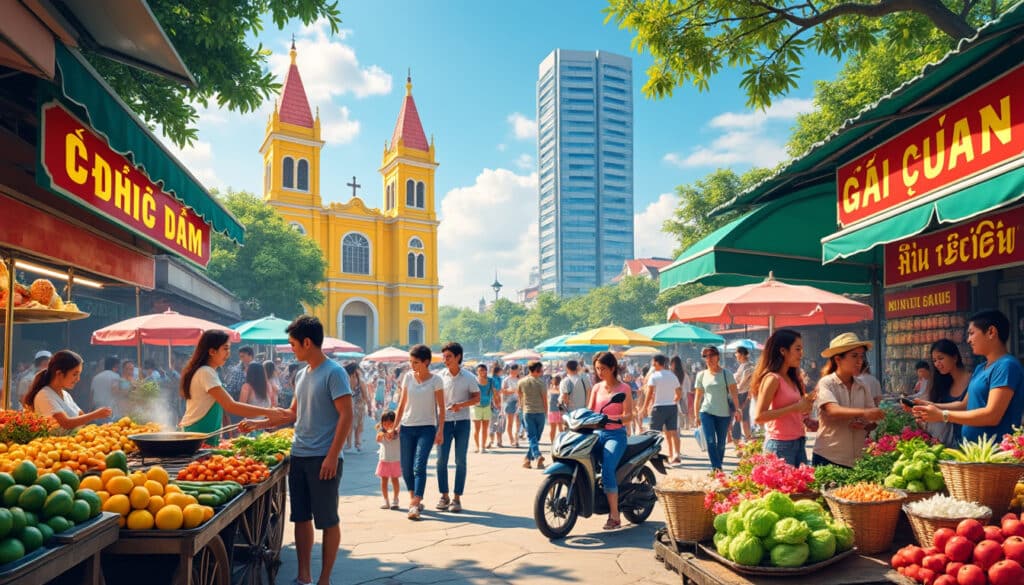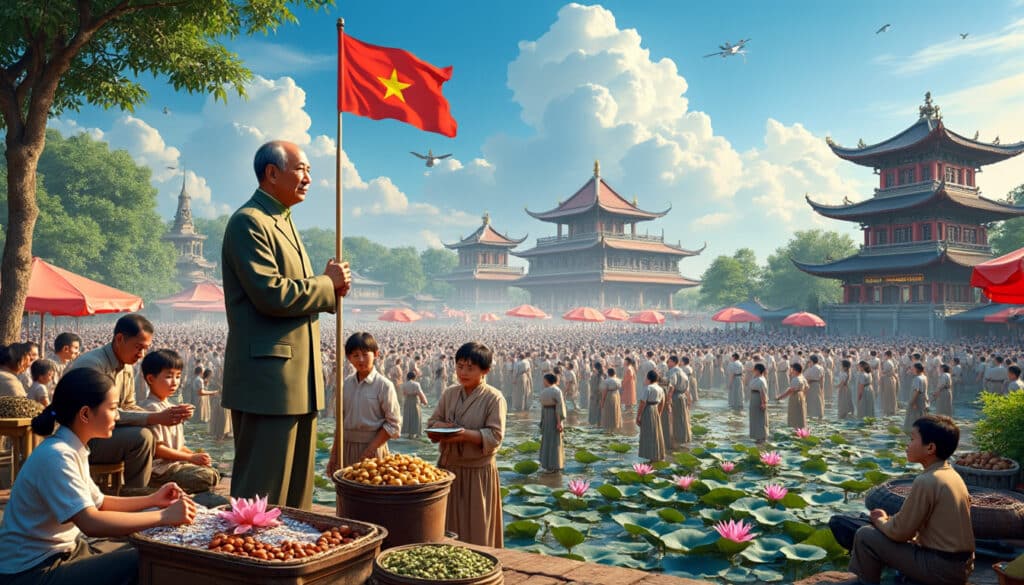Ho Chi Minh City, with its rich tapestry of cultural influences and historical significance, stands as a beacon of celebration in Vietnam. Here, traditions old and new intermingle, creating a vibrant landscape of festivities. From the pulsating energy of the Tết Festival to the luminous glow of the Vietnamese Lantern Festival, this city is alive with color and joy. Let’s delve into the heart of these celebrations, exploring the fusion of diverse cultural elements and the unique charm they bring to this bustling metropolis. Each festival offers a glimpse into the dynamic spirit of Ho Chi Minh City, inviting visitors and locals alike to partake in the city’s festive heart.
Exploring the Tết Festival: Ho Chi Minh City’s Grand Celebration
The Tết Festival, also known as the Lunar New Year, is the crown jewel of Vietnamese celebrations, and nowhere is its impact felt more reverently than in Ho Chi Minh City. Typically falling between late January and early February, Tết marks the beginning of the Vietnamese lunar calendar. It’s a time when the city takes on a new life, teeming with vibrant decorations, bustling markets, and an atmosphere of renewal and hope.
Families prepare for Tết weeks in advance, cleaning their homes meticulously and adorning them with peach blossoms, kumquat trees, and red envelops symbolizing prosperity and good fortune. The streets resonate with the sounds of laughter and the clinking of glasses as families reunite to celebrate. Traditional dishes such as bánh chưng (sticky rice cake) and thịt kho tàu (braised pork) are lovingly prepared and enjoyed during this season.
One cannot discuss Tết without mentioning the mesmerizing sight of fireworks illuminating the night sky, ringing in the new year with dazzling displays. Nguyen Hue Street transforms into a sprawling festival ground, lined with floral displays and cultural performances depicting the rich tapestry of Vietnamese culture. This event is the perfect opportunity for visitors to immerse themselves in the infectious joy of the local community.
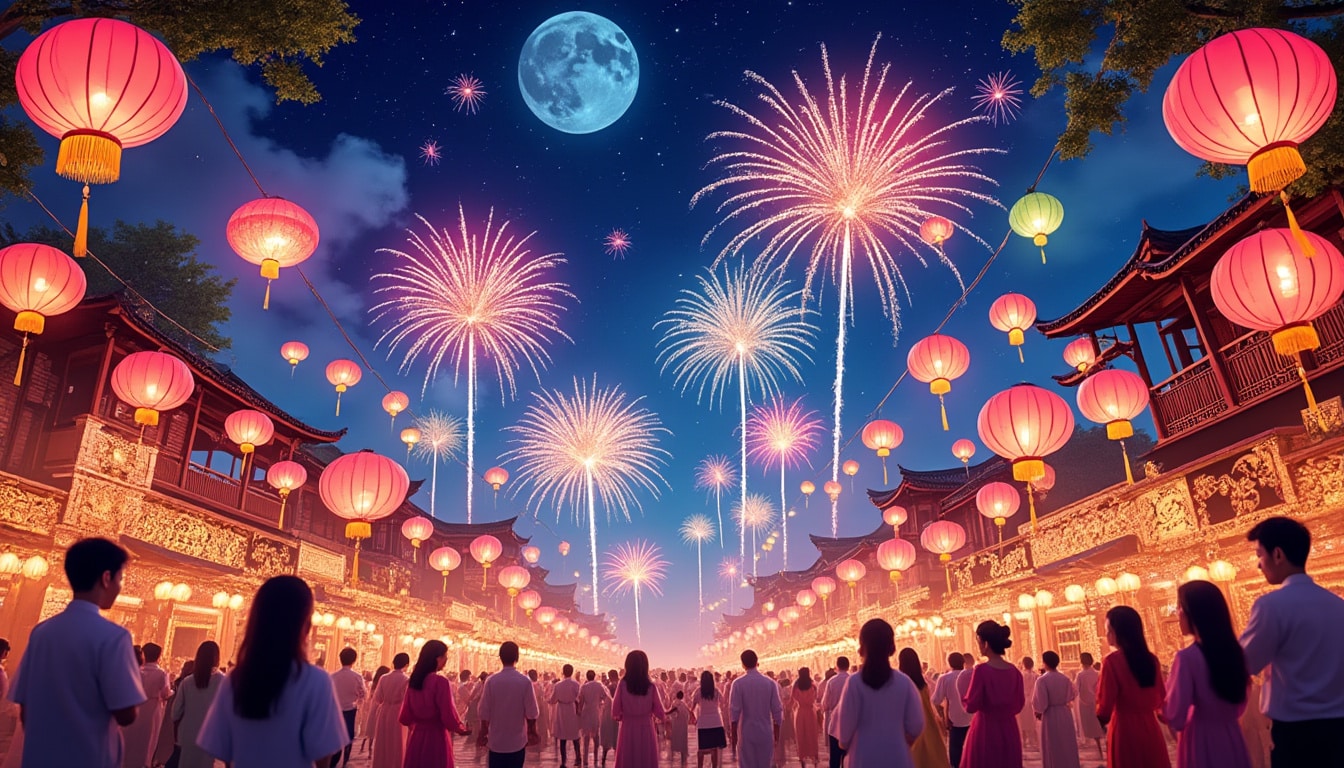
The Tết Festival is not just a celebration; it is a tradition steeped in history and cultural symbolism. It invites both young and old to partake in customs such as paying respects to ancestors, exchanging well-wishes, and giving lì xì (lucky money). These practices underscore the importance of family unity and the hope for a prosperous year ahead.
For travelers, the Tết Festival offers a peek into the authentic Vietnamese way of life. However, it’s important to note that many businesses close during this time as locals return to their hometowns or prioritize family gatherings. If visiting during Tết, it is advisable to plan ahead and embrace the slower pace as an opportunity to experience the city’s serene side.
Preparations and Traditions of the Tết Festival
The preparations for Tết involve a flurry of activities as families seek to start the new year fresh. According to custom, thorough cleaning of the home is believed to rid the space of bad luck. As the festival approaches, marketplaces become a hive of activity, with stalls selling everything from fresh flowers to festive attire. The distinct aroma of Tết foods fills the air, drawing locals and tourists alike.
During Tết, it’s customary to visit temples, such as the Vinh Nghiem Pagoda, where visitors can partake in traditional rituals and pray for blessings. This reverence extends beyond temples to the respect shown when visiting the ancestral altar at home, where family members pay homage to their forebears with offerings of food and incense. These practices reflect the deeply ingrained respect for ancestry and tradition inherent in Vietnamese culture.
Experience tip: Arrive early to Nguyen Hue Street to enjoy the enchanting flower displays and capture the beauty of the decorations before the crowds gather. Staying centrally allows easy access to the festivities while offering a peaceful retreat at the end of the day’s celebrations.
The Enchantment of the Vietnamese Lantern Festival
The Vietnamese Lantern Festival, celebrated shortly after Tết on the 15th day of the first lunar month, brings another wave of brilliance to Ho Chi Minh City. Predominantly celebrated in Cho Lon, the city’s Chinatown, this festival captivates with its colorful lanterns and energetic performances. Streets such as Luong Nhu Hoc are adorned with countless lanterns, each revealing a riddle to tease the minds of those passing by.
During the festival, families gather to craft intricate lanterns, often symbolizing hopes and dreams for the year. These lanterns are then floated on the nearest body of water as an offering to the deities, a practice believed to bring luck and prosperity. The festival is rich in folklore, and visitors can enjoy lion dances, dragon parades, and storytelling sessions that bring these ancient tales to life.
The sights and sounds of the Vietnamese Lantern Festival are truly a feast for the senses. Amidst the vibrant display of lights, the scent of incense mingles with that of street food delicacies, drawing crowds to popular food stalls offering bánh tiêu (sweet doughnuts) and chè trôi nước (sweet glutinous rice dumplings). This confluence of tastes and aromas adds to the festival’s allure, making it a must-visit for anyone exploring the city.
Engaging with local craftsmen and artists provides insight into the cultural significance of the lanterns, each designed with meticulous care and creativity. The lantern festival underscores the influence of the Chinese community on Ho Chi Minh City’s cultural tapestry, reflecting the harmonious blend of Confucian, Taoist, and Vietnamese traditions.
If you’re planning a visit to the Vietnamese Lantern Festival, aim to arrive early to avoid the evening rush. The best spots for viewing the lantern displays and performances are along the bustling streets of Chinatown. Participating in lantern-making sessions or joining a guided tour can enrich your experience, offering cultural insights that make the festival truly unforgettable.
Mid-Autumn Festival: A Time of Unity and Joy
The Mid-Autumn Festival, or Tết Trung Thu, celebrated on the 15th day of the 8th lunar month, is another cherished occasion in Ho Chi Minh City. Known as the Festival of Reunions, it is a joyful time for children and families to come together under the glow of lanterns. The streets become a kaleidoscope of color, adorned with lanterns in the shapes of stars, fish, and beloved storybook characters.
This festival is particularly significant for children, often dubbed as their very own holiday. It is customary for them to receive gifts of toys and partake in parades, carrying their lanterns as they march through the city. The air is alive with the rhythm of drums accompanying lion dances, adding to the spirited atmosphere of celebration.
Central to the Mid-Autumn Festival is the sharing of mooncakes, delicacies symbolizing completeness and unity. Traditionally filled with lotus seed paste or red bean and salted egg yolks, these round pastries are enjoyed by families gathered together, embodying the festival’s themes of wholeness and harmony.
Visitors can immerse themselves in cultural performances and storytelling sessions at venues like Tao Dan Park and Nguyen Hue Street, which host community events and activities that engage both young and old. The festival’s emphasis on family ties and nostalgia for childhood evoke warmth and joy, offering a heartwarming experience for those participating in the festivities.
Highlights of the Mid-Autumn Festival
For those eager to experience the Mid-Autumn Festival, there are several must-see activities:
- 🎆 Parades and Lion Dances: Participate in or simply enjoy the breathtaking displays of skill and artistry during lion dances that take over public spaces.
- 🌕 Lantern Displays: Admire the artistic craftsmanship of lanterns on display, each telling its own unique story.
- 🥮 Mooncake Tasting: Delight in the variety of mooncakes available, a festival staple not to be missed.
Given the festival’s popularity, accommodations can fill up quickly, so booking in advance is recommended. Walking tours provide an engaging way to explore the festival’s highlights, offering a blend of history and festive excitement that’s hard to resist.
Christmas and New Year’s Eve: Modern Festive Flair in Ho Chi Minh
Though not originally rooted in Vietnamese tradition, Christmas in Ho Chi Minh City has grown into a vibrant celebration, thanks to the city’s cosmopolitan nature and historical French influences. Shops and streets glitter with festive decorations, and the Notre Dame Cathedral becomes a focal point for holiday cheer.
The Christmas lights and decorations transform the city into a winter wonderland, attracting both locals and tourists. Despite Christmas Day not being an official public holiday, the spirit of celebration is palpable as crowds gather to explore markets, indulge in festive treats, and enjoy themed entertainment.
New Year’s Eve in Saigon is an event not to be missed. The city’s central areas, such as Nguyen Hue and the Saigon Riverfront, come alive with electrifying events, including live music, dance performances, and spectacular fireworks displays. Ho Chi Minh City welcomes the new year with an energy that pulses through its streets, uniting locals and visitors in one fantastic celebration.
Tips for holiday celebrations:
- 🕒 Plan Ahead: Popular spots may get crowded during these holidays, so arrive early to secure a good view of the fireworks.
- ⭐ Explore Local Cuisine: Don’t miss out on holiday markets offering a mixture of traditional Vietnamese and Western seasonal foods.
- 🎉 Join Public Festivities: Embrace the communal aspect by participating in New Year’s Eve events and celebrations happening across the city.
Whether you’re enjoying Christmas markets or welcoming the New Year with a spectacular fireworks show, Ho Chi Minh City’s blend of tradition and modernity offers an unforgettable festive experience. The city’s acceptance of global cultural influences makes it a unique destination for holiday celebrations, where historic charm meets modern vibrancy.
Lesser-Known Festivals Worth Exploring
In addition to the widely celebrated festivals, Ho Chi Minh City is home to lesser-known yet equally captivating celebrations worth exploring. These festivals offer unique insights into the local culture and traditions, revealing the city’s diverse and colorful spirit.
One such event is the Thien Hau Temple Festival, held in Cho Lon’s Chinese community. Taking place in the third lunar month, this festival honors Thien Hau, the sea goddess, through a series of vibrant parades, incense offerings, and lion dances. The atmosphere is charged with spiritual reverence and a strong sense of community.
Similarly intriguing is the Whale Festival in Can Gio District, celebrating the spiritual connection between local fishermen and the whale deity. This festival is marked by traditional boat races and rituals meant to ensure a safe and prosperous fishing season. Its uniqueness lies in its deep cultural roots and the unity it fosters among the coastal community.
The Nguyen Hue Flower Street Festival, inaugurated two decades ago, brightens the city from December’s end to early January. This visual delight presents thematic floral displays that draw endless crowds eager to admire and photograph the creativity on display.
Attending these festivals requires some planning, as they can be crowded occasions. However, they provide a distinct opportunity to delve deeper into Ho Chi Minh City’s less-commercialized traditions, enriching your understanding of Vietnam’s cultural heritage.
Tips for Experiencing Less-Known Festivals
To fully savor these unique festivities:
- 📅 Research Dates: Festival dates can vary based on the lunar calendar, so check in advance to plan your visit accordingly.
- 📸 Capture the Moment: Bring your camera to document the vibrant colors and traditional attire characteristic of these events.
- 👨👩👧 Engage with Locals: Take the time to talk to festival participants and locals to gain deeper insights into the significance of these cultural events.
Whether you attend the Thien Hau Temple Festival or get swept up in the maritime traditions of the Whale Festival, each event promises a memorable encounter with the cultural tapestry of Ho Chi Minh City, complementing the more widely known celebrations with authentic regional charm.
FAQ: Your Questions About Ho Chi Minh City’s Celebrations Answered
What is the best time to visit for festival enthusiasts?
The ideal time to explore Ho Chi Minh City’s festivals is around the Lunar New Year, between late January and early February, when major celebrations like Tết take place. However, festivals occur throughout the year, so there’s always something to see.
Can visitors participate in the festival activities?
Absolutely! Visitors are welcome to join in various activities, from lantern crafting to street performances. Engaging with locals enhances the experience and offers a unique glimpse into Vietnamese culture.
How should I prepare for attending these festivals?
It’s advisable to plan accommodations in advance, dress comfortably, and always be mindful of personal belongings in crowded areas. Engaging tour services can provide guided experiences that enrich your festival visits.
Are there any tips for photography during festivals?
Yes, capturing festivals in Ho Chi Minh City can be rewarding. Arrive early to get the best lighting and angles. Always ask for consent when photographing people and avoid using a flash during cultural performances to maintain the atmosphere.
How do these festivals reflect the diverse culture of Ho Chi Minh City?
Each festival showcases different aspects of the cultural mosaic that is Ho Chi Minh City, blending influences from Vietnamese, Chinese, French, and other traditions, making the city a hub of cultural celebration and diversity.
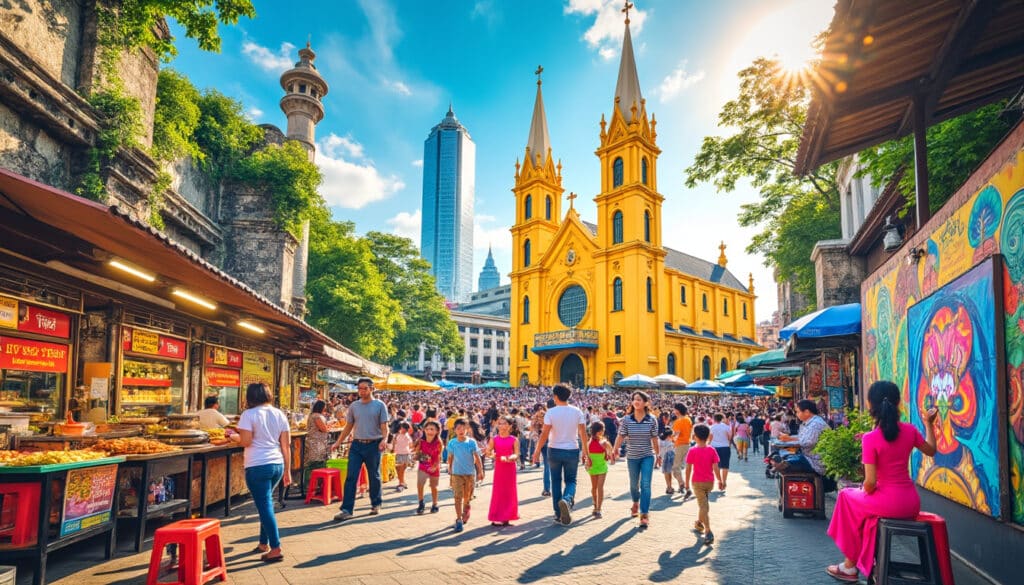
Fun Facts & Curiosities About Ho Chi Minh
Ho Chi Minh City, also known by its former name Saigon, is not just a bustling modern metropolis but a city filled with curious contrasts and intriguing historical narratives. From its storied past as the capital of South Vietnam to…
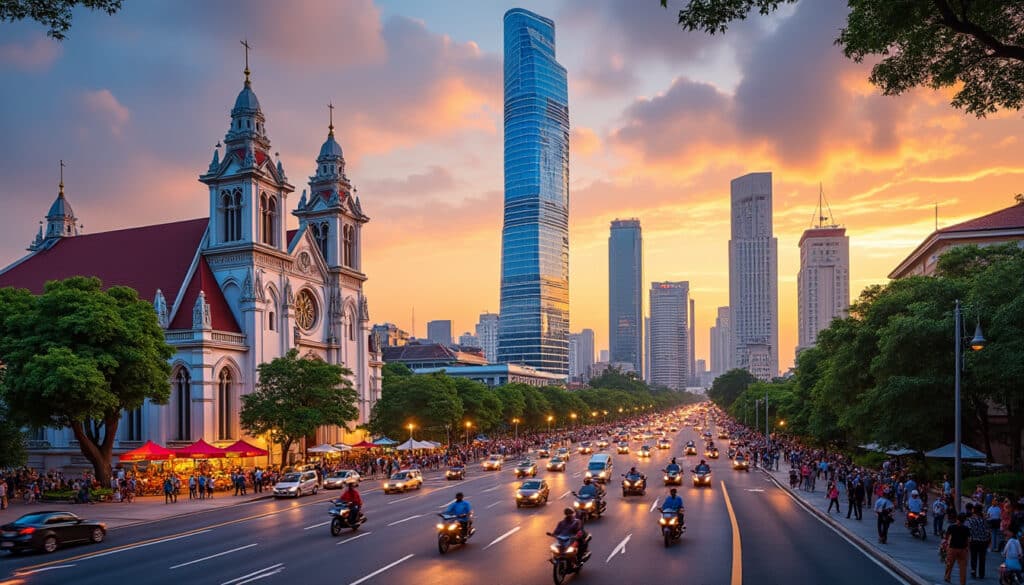
Architecture and urban features of Ho Chi Minh
Ho Chi Minh City, the bustling economic heart of Vietnam, is a captivating blend of the old and the new, a testament to its ever-evolving architectural landscape. From its historical roots as Saigon, with traditional Vietnamese and French colonial influences,…
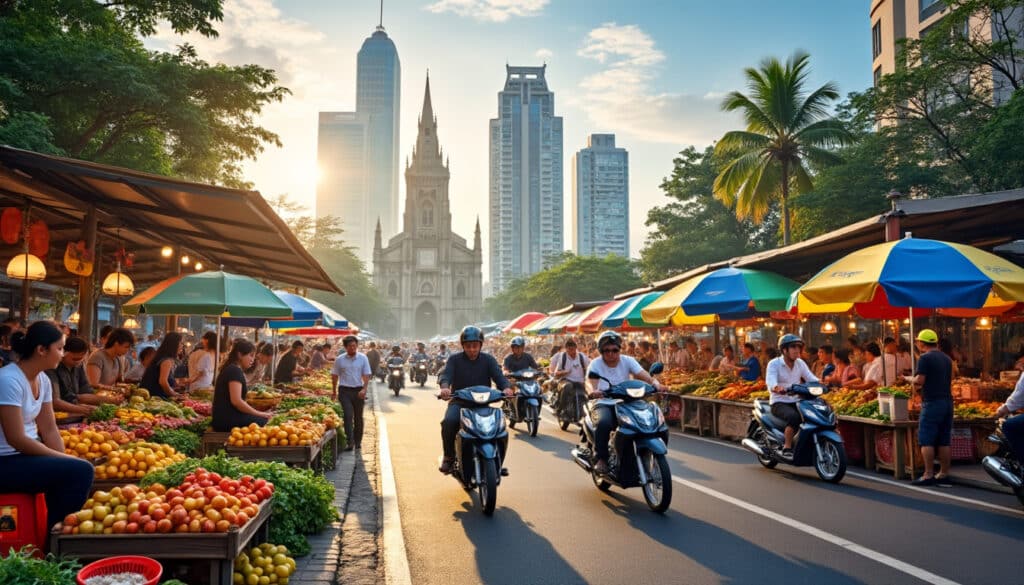
Ho Chi Minh City, once known as Saigon, is a vibrant and bustling metropolis that captures the essence of a city constantly on the move. Life here hums with an eclectic mix of tradition and modernity, where the past and…

Demographics and geography of Ho Chi Minh
Ho Chi Minh City, formerly known as Saigon, stands as a vibrant testament to Vietnam’s blend of tradition and modernity. Nestled between the fertile lands of the Mekong Delta and the bustling southeast, it pulsates with life and energy. As…

Language and spelling of Ho Chi Minh
In the bustling streets of Ho Chi Minh City, language serves as both a bridge and a barrier. The city’s unique linguistic landscape, a product of its rich history and rapid modernization, reflects the dynamic interplay between tradition and change.…
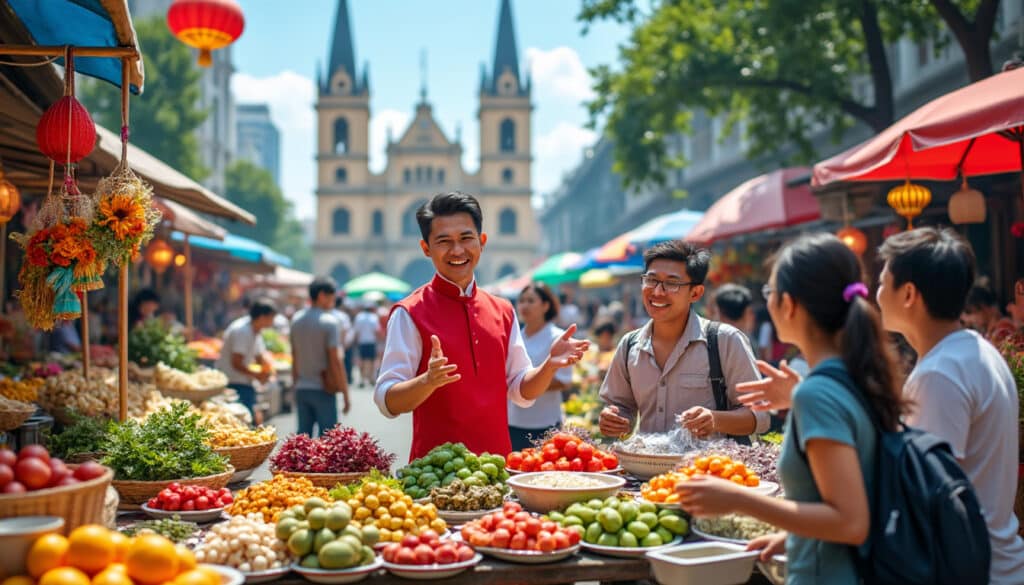
Local tips for tourists in Ho Chi Minh
Ho Chi Minh City, a bustling metropolis teeming with energy, is a gem in Southeast Asia that offers an intoxicating blend of history, culture, and modernity. From its vibrant street markets and delicious street food to its historical sites and…
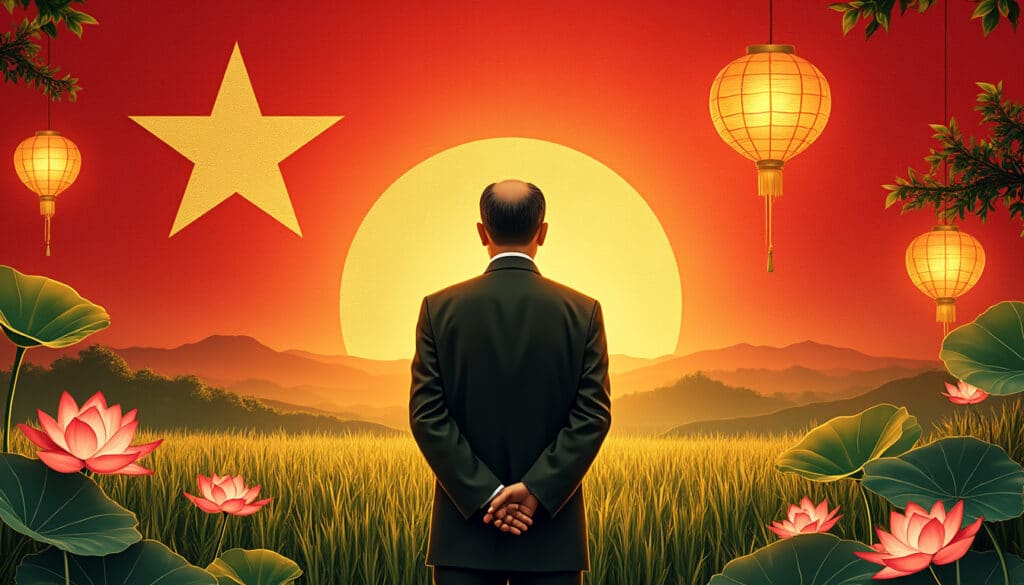
Names, flags, and identity of Ho Chi Minh
The legacy of Ho Chi Minh is deeply interwoven with the identity and history of Vietnam. Known by many names and represented by various flags throughout his life, Ho Chi Minh remains an iconic figure whose influence extends beyond Vietnam.…
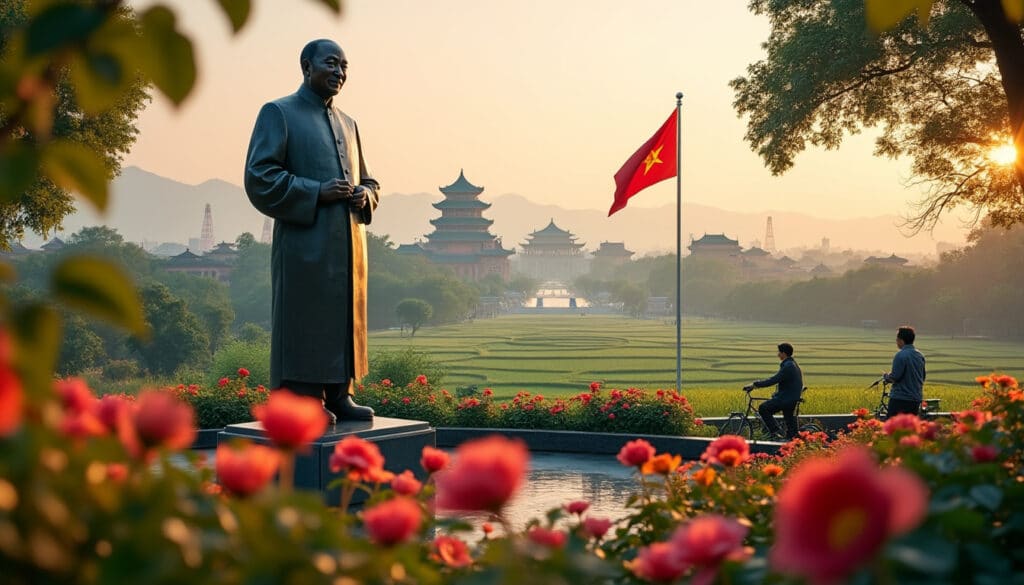
Reputation and identity of Ho Chi Minh
In the heart of Vietnam, the legendary figure of Ho Chi Minh continues to captivate minds, dominating discussions related to national identity and the nation’s storied past. An icon of resilience and strategic acumen, his image is immortalized in everything—from…
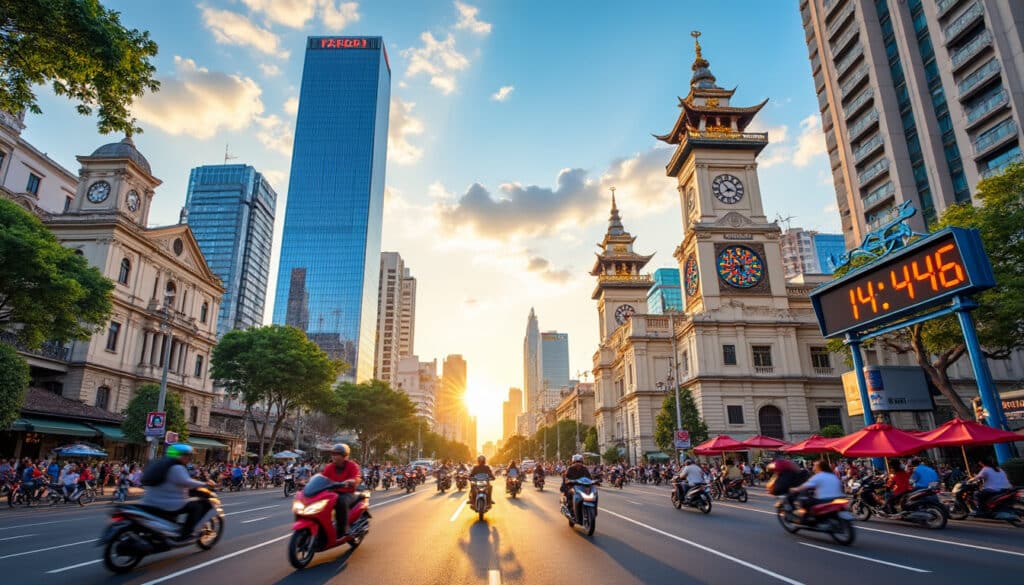
Time and time zone in Ho Chi Minh
Ho Chi Minh City, a bustling metropolis in Vietnam, is a city that never sleeps, where the hum of scooters is the soundtrack to daily life and the aroma of strong coffee permeates the air. It’s a place where time…
Unusual facts and social issues in Ho Chi Minh
Ho Chi Minh City, often referred to as Saigon, is a vibrant metropolis teeming with history, culture, and an array of fascinating quirks. Despite its rapid modernization, the city retains an intricate blend of past and present, where unique facts…
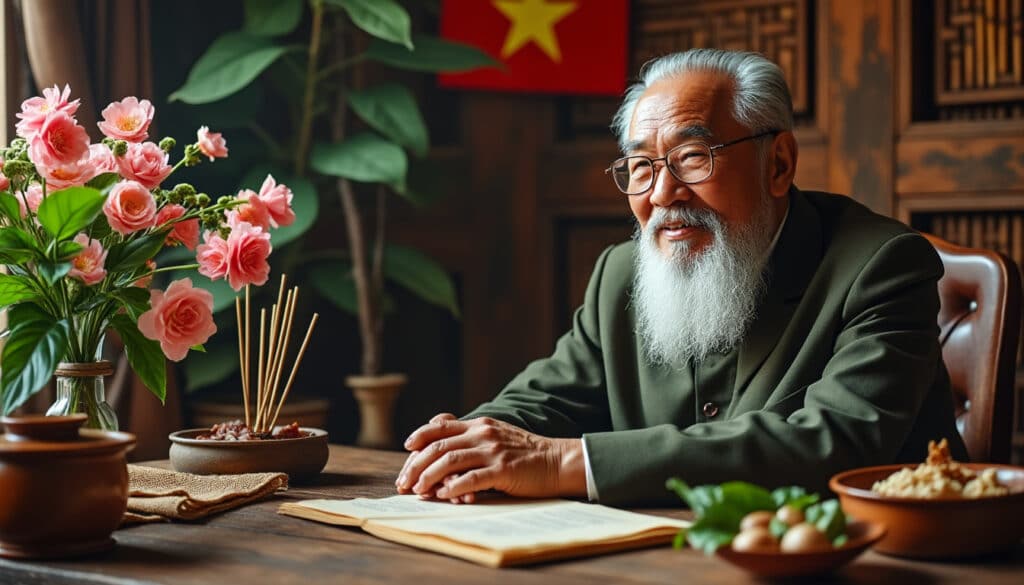
What does Ho Chi Minh look, smell, feel like?
Ho Chi Minh City, often referred to as Saigon, is a bustling metropolis in southern Vietnam that offers an unparalleled sensory experience. From the sleek skyline that reflects its modern aspirations to the fragrant aromas that fill the vibrant streets,…

